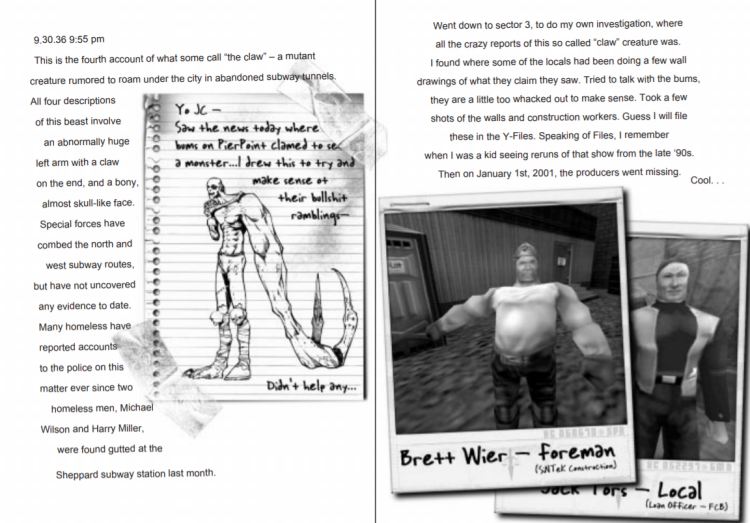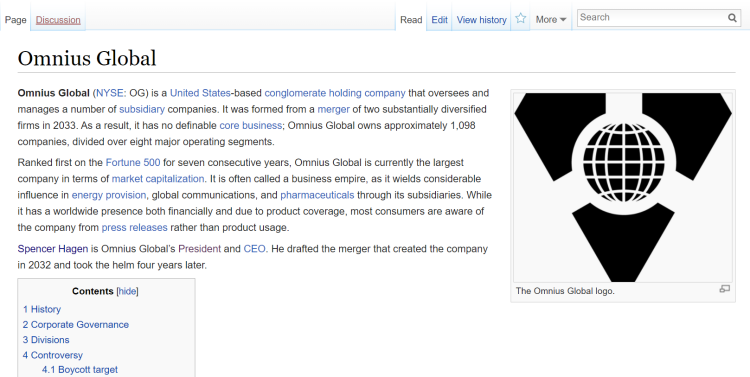
Much to my chagrin, Neurocracy did not leap fully formed from the idea of using Wikipedia as a medium for interactive fiction. When this narrative device occurred to me, I applied it to a sci-fi world that had been taking different shapes for years prior, a process inextricably linked to two of my favourite games: Deus Ex and Half-Life. In this blog post, I would like to talk about the specific significance these two games hold to Neurocracy's early development, with one teaching me about worldbuilding-as-narrative and the other showing me that, if I wanted to create something of my own, I could go ahead and do that.
Deus Ex
Deus Ex is a game I replay at least once a year, and each time I uncover new things, make fresh connections, and look forward to the conversation with Morpheus. I first played it when it came out in 2000 after having exhausted its surprisingly extensive demo, which included a significant chunk of the game's opening missions. Deus Ex is an incredibly well-written game and replaying the demo several times resulted in me scouring every corner of every level for additional story content, an approach I carried through in the full game.
I found myself fascinated most by the in-universe text made available through datacubes, computer terminals, newspapers, magazines, and books found throughout the levels, all of which suggested a world much larger than what was rendered for the game or exposited in dialogues. Many of Deus Ex's secondary storylines unfold across these texts, such as the NSF's retreat from the Liberty Island siege that opens the game. Piecing together this subplot, personified by a group of NSF members communicating with each other through electronic messages, gave the mid-game reveal that Paul Denton is working with the NSF against UNATCO an emotional edge it otherwise would have lacked.
Later in the game, I came across a cursory mention of JC Denton being infected with the Gray Death, a debilitating disease that informs much of Deus Ex's worldbuilding. Probing this mystery led to the discovery that the Gray Death is not a disease, but the planned outcome of nanotechnology introduced to people who have not been engineered to tolerate it, with JC "testing positive" because he has been enhanced with nanotech augmentations. It felt thrilling to have made this connection entirely through exploration and an understanding of the full text before it was ever spelled out directly.
This discovery was facilitated by Deus Ex's detailed and internally consistent depiction of near-future technology, which is grounded in authentic scientific terminology. For example, each of JC Denton's augmentations comes with a bit of UI flavour text describing the player ability it bestows (increased running speed) in terms of nanotech enhancements (ionic polymeric gel myofibrils woven into the leg muscles). While bordering on technobabble, these descriptions struck me as integral to the story of Deus Ex, and I can draw a direct line from considering the narrative potential of this attention to detail to how Neurocracy blends science and fiction.
More broadly, if Neurocracy qualifies as a plausible near-future world involving a fictional disease and presented through in-universe texts, then Deus Ex continues to be my touchstone for creating such a world. It prompted me to reach out to Deus Ex co-writer Sheldon J. Pacotti, who ended up browsing an early version of Neurocracy and consulting on the AI aspects of its worldbuilding. He also thinks it's pretty rad, which is pretty rad.
Half-Life
I only played Half-Life one year after it came out in 1998 because my crippling fear of headcrabs initially bounced me off the version that was bundled with the purchase of a new graphics card. This delay gave SiN, a game Half-Life ended up eclipsing upon release, a chance to inspire the development of Neurocracy in the meantime. While I enjoyed playing SiN for the edgy '90s-era shooter that it was, I was more interested in the game's manual, with its first thirty pages devoted to a diary written by the game's protagonist, John Reginald Blade.

The diary was used to explore SiN's near-future setting and the backstories of its characters, making use of concept art, 3D renders, and clippings of in-universe documents to complement the text. I ended up rereading this manual irrespective of the game for the same reasons the worldbuilding of Deus Ex spoke to me. Pretty sure it also influenced the decision to pin down Neurocracy's visual style as "the concept art is the final art."
I was dabbling in creating multiplayer maps for Unreal Tournament when I finally did play and finish Half-Life in 1999, prompting me to try out its level editor as well. That didn't click for me, so instead I started using Milkshape 3D to tinker with the game's models and textures. My first successful attempt was to upgrade Half-Life's soldier enemies by porting over the more detailed models that came with the Opposing Force expansion pack. After learning how to create and animate custom 3D models, I became active in Half-Life's modding community and started thinking about developing a mod of my own.
Since I had no idea what the scope of such an undertaking would be, I just went ahead and dove right in, which somehow led to me directing a small team of enthusiast coders, modellers, and mappers to create a singleplayer mod for Half-Life. In the spirit of Opposing Force and Blue Shift, this mod would tell the story of another character viewpoint on the events of the original game, namely that of a Russian spy who had infiltrated the Black Mesa research facility under an assumed identity in order to steal the secrets of teleportation. Eventually titled Half-Life: Escape Velocity, the mod never took off beyond the development of some initial art assets, which are still archived at ModDB.
When Half-Life 2 came out in 2004, I decided to not learn my lesson by immediately tackling another wildly overambitious mod project, this one a total conversion titled Omnius Global and set in a near-future cyberpunk dystopia freely inspired by Deus Ex in both story and gameplay. The below video demonstrates the extent to which this project saw the light of day: a single character model of the evil CEO of an evil megacorporation, built on top of Half-Life 2's Wallace Breen. Fun fact: my father provided the likeness for this model.
Quite unsurprisingly, Omnius Global also collapsed in on itself, but it did produce two pieces of writing that proved invaluable in setting the stage for Neurocracy. The first was an outline of Omnius Global's story, written as a screenplay in the same way Marc Laidlaw drafted short vignettes in the form of movie scenes to set Half-Life 2's tone without the expectation that those scenes would be translated directly into the game. I learned about this approach from Half-Life 2: Raising the Bar, an excellent art book that chronicles the development of Half-Life, its various mods, and its sequel.
The Omnius Global screenplay ended up counting 220 pages (close to a four-hour movie) and detailed the player's journey from the inciting incident to the final confrontation with the evil CEO. It's absolute dogshit, written as a hackneyed conspiracy thriller with overlong monologues and exposition scenes, no meaningful female characters to speak of, and action/stealth encounters contrived to make the player face dozens of enemies. As dubiously as I look back on the Omnius Global screenplay now, it was the first time all the ideas I had floating around for my own sci-fi world in the vein of Deus Ex coalesced into something that was complete, scripted from start to finish.
The second piece of writing to come out of the Omnius Global project was, without realising it at the time, the earliest conceptual version of Neurocracy: a story bible of Omnius Global's worldbuilding details written and formatted to resemble Wikipedia articles through the use of a custom MediaWiki. I assembled this wiki as the screenplay took shape, which created a feedback loop between the two as I came up with ideas in one and developed them in the other. If only for my own enjoyment, I also made the wiki appear as authentic as possible by embedding hyperlinks to Wikipedia and adding placeholder photos, maps, diagrams, and logos to the various articles. That should have been a sign.
Omnipedia
After Omnius Global predictably tanked, all the writing work sat in the drawer for years, until I started toying with the idea of turning it into a novel. A few months of idle ideation and jotting down errant lines of cool-sounding dialogue went on to erode any faith in my ability to write convincing prose or engaging characters. Worldbuilding was definitely my favourite part of writing anything and could I maybe somehow just do that?

With the Omnius Global wiki staring me in the face, I finally got the idea to have a futuristic version of Wikipedia serve as the medium for the sci-fi world that had been crystallising for over a decade. Once the implications of this narrative device sank in, I reached out to my friend Matei Stanca to design a copy of Wikipedia. That's another hand Half-Life had in Neurocracy's development: I had first met Matei as a fellow 3D modeller in the Half-Life modding community and I knew them to be a talented and dedicated web developer after they fashioned this very blog for me in 2009.
Our first approach was to have this futuristic Wikipedia, which I dubbed Omnipedia, exist on a single date in the year 2049 after the main story had concluded, with players coming in and having to click their way through all available articles to piece together everything leading up to the (immediately available) ending. This use of an in medias res opening felt limiting in that it rendered the text static, whereas Wikipedia is characterised by its constant, sometimes frantic article updates. When we outfitted Omnipedia with a revision history similar to that of Wikipedia, we were able to serialise Neurocracy's story and carry over the dynamic aspect of Wikipedia's content. Players who dive into Neurocracy only after the final episode has been released will still be able to sample this first approach.
As I attempted to categorise Neurocracy ahead of introducing it to a wider audience, I realised it slotted neatly into the hypertext fiction genre. After posting about the project in the Interactive Fiction Community Forum and presenting it to fellow developers at the AdventureX Narrative Games Convention, I felt confident enough to submit an early excerpt of Neurocracy, containing eight hyperlinked articles spread across three episodes, to 2019's IntroComp. The enthusiastic response to the excerpt, which took third place and garnered positive feedback, paved the way for our first public announcement and our successful Kickstarter campaign.
And that brings us here, with Neurocracy having taken a shape I never could have anticipated and closer to release than I had ever dared hope. I'm so excited to finally share the world of 2049 with you all and seeing what it might inspire in turn.
Add new comment